Introduction to Words XML Features
Introduction to Word s XML Features
The first thing to note about the XML features described in this chapter is that most of them are only available in Microsoft Office Professional Edition 2003 and the standalone version of Microsoft Office Word 2003. If you work with other Office Editions such as Microsoft Office Standard Edition 2003, Microsoft Office Student and Teacher Edition 2003, or Microsoft Office Basic Edition 2003, the XML features described in this chapter are not available.
Many of the XML features of Word are accessed via Word's XML Structure task pane. To show the XML Structure task pane, display the task pane if it is not already displayed by choosing Task Pane in Word's View menu. The task pane has a drop-down menu from which the XML Structure task pane can be selected, as shown in Figure 22-1.
Figure 22-1. Selecting the XML Structure task pane from the task pane drop-down menu.
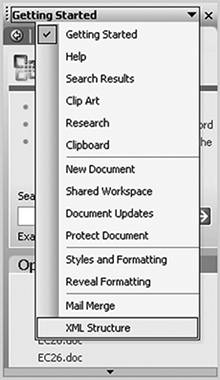
The XML Structure task pane prompts you to go to the Templates and Add-Ins dialog to attach an XML schema to the document. To get to the Templates and Add-Ins dialog, you can click the Templates and Add-Ins hyperlink shown in the task pane in Figure 22-2 or choose Templates and Add-Ins from the Tools menu and then click the XML Schema tab.
Figure 22-2. The XML Structure task pane prompts you to go to the Templates and Add-Ins dialog to add an XML schema.
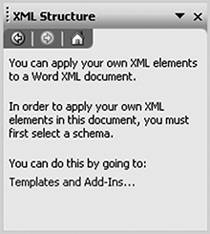
Figure 22-3 shows the Templates and Add-Ins dialog. This dialog shows available XML schemas that can be attached to the Word document by checking the check box next to an available schema. It also provides a button to add a new schema to the document.
Figure 22-3. The Templates and Add-Ins dialog with the XML Schema page selected.
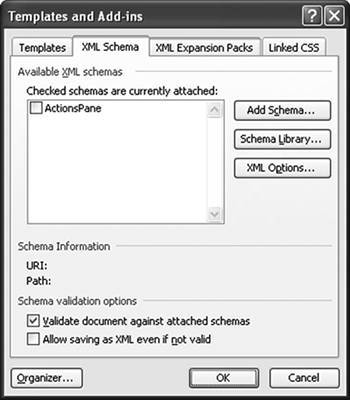
To add a new schema to the document, click the Add Schema button. When you click the Add Schema button, you are prompted to browse to the schema file you want to add to the document. Let's use the book order schema we created in Chapter 21, "Working with XML in Excel." After you select the schema, the Schema Settings dialog appears, as shown in Figure 22-4. Let's enter BookOrder as an alias or friendly name for the book order schema.
Figure 22-4. Picking an alias for a newly added schema in the Schema Settings dialog.
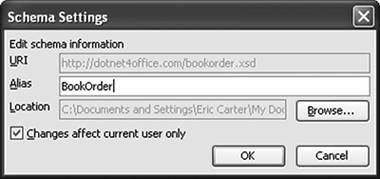
Click OK to dismiss the Schema Settings dialog. Doing so returns you to the Templates and Add-Ins dialog. The book order schema has been added, as shown in Figure 22-5, and is attached to the current document as shown by the checked check box next to the BookOrder schema. The BookOrder schema can be detached from the document by unchecking the check box.
Figure 22-5. The BookOrder schema has been attached to the Word document.
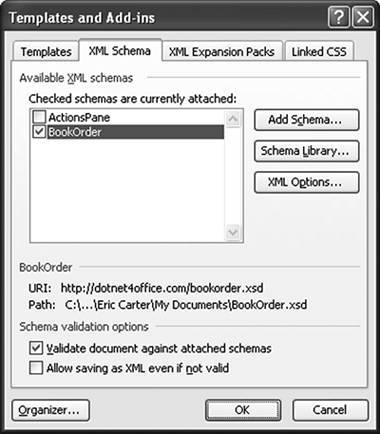
Now that the BookOrder schema has been added, it will be available for attachment to other documents because Word automatically adds any added schemas to Word's schema library. To manage Word's schema library, click the Schema Library button in the Templates and Add-Ins dialog. The Schema Library dialog appears, as shown in Figure 22-6. This dialog provides the same Add Schema button that lets you add new schemas. It also can edit the schema settings dialog for an already added schemafor example, you can select a schema and click the Schema Settings button to assign the book order schema a different friendly name. A Delete Schema button lets you delete a schema from the schema library.
Figure 22-6. The Schema Library dialog.
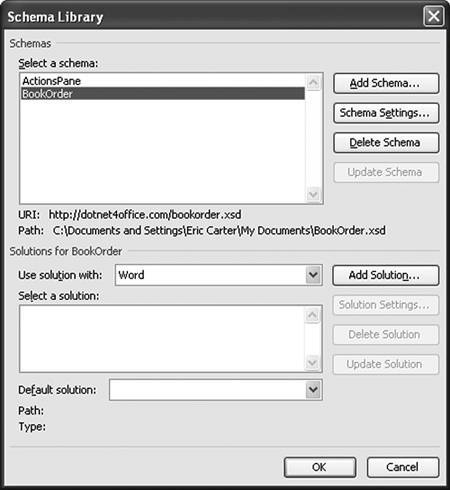
The bottom half of the Schema Library dialog provides options to associate smart document solutions with a document to which a particular schema is attached. In this book, we do not cover this part of Word's functionality because VSTO 2005 provides an easier way to build Word solutions through the ActionsPane mechanism described in Chapter 15, "Working with Actions Pane." However, we do cover the ability to use the Solutions section to associate an XSLT file with a particular schema.
When you close the Schema Library dialog and the Templates and Add-Ins dialog, the XML Structure pane is updated to show elements from the book order schema, as shown in Figure 22-7. With the book order schema attached to the document, you are now ready to start applying XML elements to the document.
Figure 22-7. The XML Structure dialog with the book order schema attached to the document.

Part One. An Introduction to VSTO
An Introduction to Office Programming
- Why Office Programming?
- Office Object Models
- Properties, Methods, and Events
- The Office Primary Interop Assemblies (PIAs)
- Conclusion
Introduction to Office Solutions
- The Three Basic Patterns of Office Solutions
- Office Automation Executables
- Office Add-Ins
- Code Behind a Document
- Conclusion
Part Two. Office Programming in .NET
Programming Excel
- Ways to Customize Excel
- Programming User-Defined Functions
- Introduction to the Excel Object Model
- Conclusion
Working with Excel Events
Working with Excel Objects
- Working with Excel Objects
- Working with the Application Object
- Working with the Workbooks Collection
- Working with the Workbook Object
- Working with the Worksheets, Charts, and Sheets Collections
- Working with Document Properties
- Working with the Windows Collections
- Working with the Window Object
- Working with the Names Collection and Name Object
- Working with the Worksheet Object
- Working with the Range Object
- Special Excel Issues
- Conclusion
Programming Word
Working with Word Events
Working with Word Objects
- Working with Word Objects
- Working with the Application Object
- Working with the Dialog Object
- Working with Windows
- Working with Templates
- Working with Documents
- Working with a Document
- Working with the Range Object
- Working with Bookmarks
- Working with Tables
- Conclusion
Programming Outlook
- Ways to Customize Outlook
- Introduction to the Outlook Object Model
- Introduction to the Collaboration Data Objects
- Conclusion
Working with Outlook Events
Working with Outlook Objects
- Working with Outlook Objects
- Working with the Application Object
- Working with the Explorers and Inspectors Collections
- Working with the Explorer Object
- Working with the Inspector Object
- Working with the NameSpace Object
- Working with the MAPIFolder Object
- Working with the Items Collection
- Properties and Methods Common to Outlook Items
- Outlook Issues
- Conclusion
Introduction to InfoPath
- What Is InfoPath?
- Getting Started
- Form Security
- Programming InfoPath
- Data Source Events
- Form Events, Properties, and Methods
- Conclusion
Part Three. Office Programming in VSTO
The VSTO Programming Model
- The VSTO Programming Model
- VSTO Extensions to Word and Excel Objects
- Dynamic Controls
- Advanced Topic: Dynamic Host Items
- Advanced Topic: Inspecting the Generated Code
- VSTO Extensions to the Word and Excel Object Models
- Conclusion
Using Windows Forms in VSTO
- Using Windows Forms in VSTO
- Introduction
- Adding Windows Forms Controls to Your Document
- Writing Code Behind a Control
- The Windows Forms Control Hosting Architecture
- Properties Merged from OLEObject or OLEControl
- Adding Controls at Runtime
- Conclusion
Working with Actions Pane
Working with Smart Tags in VSTO
- Introduction to Smart Tags
- Creating Document-Level Smart Tags with VSTO
- Creating Application-Level Smart Tags
- Conclusion
VSTO Data Programming
- VSTO Data Programming
- Creating a Data-Bound Customized Spreadsheet with VSTO
- Creating a Data-Bound Customized Word Document with VSTO
- Datasets, Adapters, and Sources
- Another Technique for Creating Data-Bound Spreadsheets
- Caching Data in the Data Island
- Advanced ADO.NET Data Binding: Looking Behind the Scenes
- Binding-Related Extensions to Host Items and Host Controls
- Conclusion
Server Data Scenarios
- Populating a Document with Data on the Server
- Using ServerDocument and ASP.NET
- A Handy Client-Side ServerDocument Utility
- The ServerDocument Object Model
- Conclusion
.NET Code Security
- .NET Code Security
- Code Access Security Versus Role-Based Security
- Code Access Security in .NET
- Location, Location, Location
- Strong Names
- Publisher Certificates
- Trusting the Document
- Deploying Policy to User Machines
- Conclusion
Deployment
- Deployment
- VSTO Prerequisites
- Deploying to an Intranet Shared Directory or Web Site
- Local Machine Deployment Without a Deployment Manifest
- Editing Manifests
- Creating Setup Packages
- Advanced Topic: Deploying Network Solutions to Be Cached Locally
- Conclusion
Part Four. Advanced Office Programming
Working with XML in Excel
- Introduction to Excels XML Features
- Introduction to XML Schema Creation in Visual Studio
- An End-to-End Scenario
- Advanced XML Features in Excel
- Excel-Friendly XML Schemas
- VSTO Support for Excel Schema Mapping
- Conclusion
Working with XML in Word
- Introduction to Words XML Features
- An End-to-End Scenario: Creating a Schema and Mapping It into a Word Document
- Exporting the Mapped XML in the Document to an XML Data File
- Importing an XML Data File into the Mapped Document
- The XML Options Dialog
- VSTO Support for Word Schema Mapping
- VSTO Support for the WordML File Format
- Conclusion
Developing COM Add-Ins for Word and Excel
- Introduction to Add-Ins
- Scenarios for Using Add-Ins
- How a COM Add-In Is Registered
- Implementing IDTExtensibility2
- Writing a COM Add-In Using Visual Studio
- The Pitfalls of MsCoree.dll
- COM Interop and Regasm.exe
- Shimming: A Solution to the Problems with MsCoree.dll
- Conclusion
Creating Outlook Add-Ins with VSTO
EAN: N/A
Pages: 214
